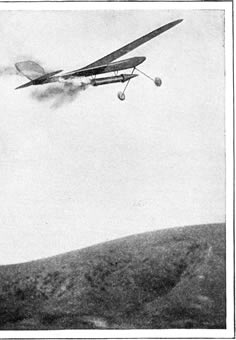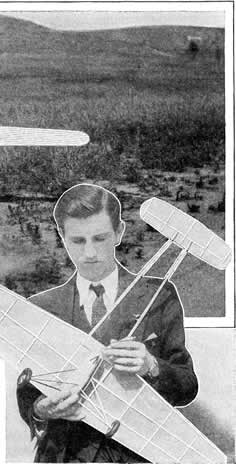|
|
|
|||
|
|
||||
|
|
||||
| Plan: Cole's Rocket Plane | ||||
|
|
HOME | SITE MAP | FORUM | CONTACT |
|
||
|
ABOUT | MOTORS | MODELS | ARCHIVE | HISTORY | STORE | FAQ | LINKS
|
|
|
|
|
|
||||||||||||||
|
by Dick Cole Reprinted from Modern Mechanix and Inventions, Jan. 1933, pp. 130ff. Model plane builders will find a new experience in this little rocket-powered job. It takes off in a swish of sparks, ascends to a high altitude then levels off for a long flight. Experiments with the plane will teach you principles of rocket propulsion, which may be utilized in the planes and space rockets of the future. |
|
||||||||||||||

First, let us consider the whys and wherefores of rocket propulsion. The fundamental principle conforms to one of the first "laws" one learns in the physics class: "reaction equals action." In other words, where a force is applied in one direction, there is always an equal force applied in the opposite direction. So, when a quantity of gases is ejected from a tube, the reactionary force tends to move the tube in the opposite direction. The fundamental composition of any rocket consists of liquids or solids, which, through chemical action, are rapidly converted into gases. The rocket with which most people are more or less familiar, is the common powder rocket – the "Fourth of July" kind. Fig. 1 shows the make-up of this type rocket. It consists simply of a tube rolled of tough paper and filled with a powder charge. A conical cap on the tip contains the "star shells" to provide a miniature meteor shower. Of course, when the rocket is used on a model plane, these star shells are removed. An efficient, high-speed rocket is used on the model plane herewith described. In terms of physics, the kinetic energy of the rocket is converted into potential energy, by carrying the model high in the air, where it possesses potential energy because of its relative position. The model can then make a long- endurance flight, depending upon its gliding angle. Constructing Fuselage of the Plane |
|
 [Above] The model rocket plane in flight. With a high-speed rocket hooked to fuselage, the plane will ascend to altitude of about 300 feet, then level off for a long flight of 15 minutes or more, depending upon the gliding angle.
- Modern Mechanix and Inventions,
Jan. 1933 (p. 130) |
|||||||||||||
|
|
|
||||
This construction provides a very light body of sufficient strength for a rocket plane, since it is not subjected to the stresses of a rubber hand motor. The wing, stabilizer, and rudder construction are quite obvious. The dihedral is formed by crushing the wood with a blunt edge on the dotted lines and dripping a little boiling water in the groove. Afterward coat it copiously with ambroid. The stabilizer and rudder are tapered toward the edges. The stabilizer must be mounted on the body parallel to the center-line. Note the wire loop in the wheel undercarriage. This supports the nose of the rocket tube. Another twisted wire cradle supports the rear of the rocket. A piece of sheet lead approximately four ounces in weight is shaped as shown in the pattern, and is wrapped around the nose of the body. After the exact weight required is determined by experiment, the lead is glued and pinned permanently to the nose. After all the units have been built up, the plane can be assembled. Temporarily, the wing is held with a rubber band until its exact point of balance is found. The only angle of incidence the wing should have is that provided by the taper of the body itself. The plane must give a good flat glide. Slightly adjusting the weight on the nose may be necessary. After the exact point of balance has been found, the wing is glued permanently to the body. Now for fitting the rocket. The rocket used on this model is known as a "1-lb. rocket." They can be obtained from any dealer in fireworks. The drawings show how the rocket is mounted. First mark off the center of balance of the plane without the rocket in place. Determine the center of weight of the rocket. It must be mounted with this point 1½" ahead of the center of balance. Of course, the star sheets should be removed. Afterward glue the tip back in place. Strips of asbestos paper should be glued to the body near the fuse to safeguard the wood from fuse sparks. Release Mechanism Drops Rocket When It Burns Out at Height of Flight Fig. 2 shows the automatic release for the rocket tube. A hole is bored through the rocket near the head of the powder charge. A length of 1/8" rubber is passed through the hole and led around the loops of the cradle. When the combustion reaches the rubber, it is melted, the rocket tube falls off, and the plane starts on its long glide. In starting the plane, it is not necessary to point it upward. The initial rush of gas when the rocket is set off will carry the plane skyward almost vertically. After a few seconds, when the powder has burnt away from the surface of the conical cavity, the burning of the powder in the rocket tube is less violent, and the plane will begin to straighten out. Presently the expended rocket tube will fall off, and the plane will start its earthward flight. A ten to fifteen minute flight is the usual duration. Experimenters with rocket planes should exercise great care. Experiments should not be carried on near any buildings or in an area where grass fires may be started. And one should not encourage a crowd of people to witness one's first experiment. For "safety first," it is suggested that early experiments be carried out on the deck of a boat well away from the shore. If the model is well doped, a little wetting won't hurt it. |
|

- Modern Mechanix and Inventions,
Jan. 1933 (p. 133) |
|||
|
|
|
||||
|
Plan for Cole's Rocket Plane, Fig. 1 (see Fig. 2 below) (A larger copy of the plan (Fig. 1) is also available to view or download). Fig. 1. Chief over all [sic] dimensions are to be found in this drawing. Before hooking on the rocket, take off the cap, remove the star shells and glue cap back in place. For proper balance, the center of weight of the rocket should be set 1½ in. ahead of the center of balance of the plane. Weight of lead will have to be determined by experimentation. Note that asbestos paper is glued around fuselage to protect it from sparks of rocket.  Plan for Cole's Rocket Plane, Fig. 2 (A larger copy of the plan (Fig. 2) is also available to view or download). Fig. 2. Constructional details of all units are given here. The body is built up from three strips of 1/16 in. balsa wood cut to the approximate shape shown. The edges are beveled to 30 degrees, and are brought together and glued to form the triangular cross-section. Triangular blocks are set at nose and tail for rigidity. Dihedral is formed by crushing wood of wing with a blunt edge and dripping a little boiling water in the groove. Afterwards coat in copiously with ambroid. Note the mechanism for releasing the rocket when it has burned out. A hole is bored through the rocket near the head of the powder charge and a length of rubber band led through it and passed around the loops of the cradle. When the combustion reaches the rubber it melts, releasing the rocket. Plane then goes into a glide.  |
|||||
|
|
|
||||
|
|
|
|
|
|
|
|
Acknowledgements - Article and plan contributed by Ben Nead |
|
|
|
|
ABOUT | MOTORS | MODELS | ARCHIVE | HISTORY | STORE | FAQ | LINKS |
|
|
Terms of Use
|
Queries? Corrections? Additions?
Please
contact us.
|
|